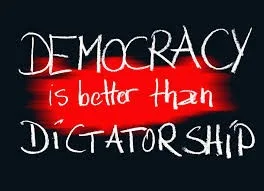What Is Democracy And What Is Dictatorship?
Democracy and dictatorship represent two contrasting forms of governance, each characterized by distinct principles, structures, and principles of authority.
Democracy:
Definition:
Democracy is a form of government where the power is vested in the hands of the people, either directly or through elected representatives. It emphasizes the idea of political equality, participation, and protection of individual rights.
Key Features:
Popular Sovereignty: In a democracy, the ultimate authority rests with the people. Citizens participate in decision-making through voting in elections and expressing their views on various issues.
Rule of Law: Democracies are typically characterized by the rule of law, where laws apply equally to all citizens, including those in positions of power. This ensures fairness and accountability.
Protection of Individual Rights: Democracies prioritize the protection of individual rights and freedoms. Constitutional frameworks, such as a Bill of Rights, often exist to safeguard citizens' liberties.
Regular, Free, and Fair Elections: Democratic systems involve regular elections where citizens choose their representatives. These elections are expected to be free and fair, allowing for peaceful transitions of power.
Pluralism and Tolerance: Democracies celebrate diversity and encourage a multiplicity of voices. Tolerance of differing opinions and protection of minority rights are integral to democratic principles.
Civil Liberties: Democracies uphold civil liberties, such as freedom of speech, assembly, and the press. These rights enable citizens to express their opinions and engage in public discourse.
Examples of democracies include the United States, India, Germany, and many others.
Dictatorship:
Definition:
Dictatorship is a form of government characterized by a concentration of power in the hands of a single individual or a small group. In a dictatorship, authority is often maintained through force or coercion, and political opposition is typically suppressed.
Key Features:
Centralized Authority: In a dictatorship, power is concentrated in the hands of a single leader (dictator) or a small group of individuals. Decision-making is often highly centralized.
Limited Political Pluralism: Dictatorships usually limit political pluralism, suppressing opposition parties and restricting political freedoms. Dissent is often met with repression.
Absence of Free Elections: Dictatorships often lack regular, free, and fair elections. The ruler or ruling group may maintain power through non-democratic means, such as military force or political manipulation.
Limited Civil Liberties: Civil liberties, such as freedom of speech and assembly, are often restricted in dictatorships. The government may control the media and limit citizens' ability to express dissent.
Lack of Rule of Law: Dictatorships may not adhere strictly to the rule of law. The legal system may be used to justify the ruler's actions rather than ensuring justice and equality.
Limited Protection of Individual Rights: Individual rights are often subordinated to the interests of the ruler or ruling elite. Citizens may not enjoy the same level of protection for their rights as in a democracy.
Examples of dictatorships include historical regimes like Nazi Germany under Adolf Hitler and contemporary examples like North Korea under Kim Jong-un.
In summary, democracy and dictatorship represent fundamentally different approaches to governance. Democracy emphasizes the empowerment of the people, protection of individual rights, and the rule of law, while dictatorship centres power in the hands of a single leader or a small group, often at the expense of political pluralism and individual liberties.
Also read:- essay on why voting is important
Also read:- Essay on why rules are important
Also read:- Essay on importance of fundamental duties
Also read:- what makes India great essay
Also read:- what is democracy and what is decorators ship
Also read:- your future depends on your aspirations essay
Also read:- Should state colleges are free to attend persuasive essay

There are many points in the legal field that are not known to ordinary people who are faced with laws, rights and obligations for the first time. In such cases, the easiest way is to either read articles like https://www.natlawreview.com/article/ofac-enforcement-guidelines-responses-to-apparent-violations-and-civil-monetary or hire an experienced lawyer to advise you.
ReplyDeleteThank you for creating a platform that fosters learning, growth, and connection! Join the ranks of gamers who can't get enough of the comedic brilliance of Funny Shooter 2 Unblocked - it's a hit!
ReplyDelete